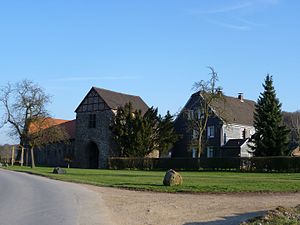House Nesselrath
| House Nesselrath | ||
|---|---|---|
|
Castle with castle gate and farmhouse |
||
| Alternative name (s): | Gut Nesselrath; Nesselrath Castle | |
| Creation time : | before 1303 | |
| Castle type : | Niederungsburg | |
| Conservation status: | Wall remains present | |
| Place: | Leichlingen (Rhineland) - Nesselrath | |
| Geographical location | 51 ° 7 '46.8 " N , 7 ° 1' 52.7" E | |
| Height: | 67 m above sea level NN | |
|
|
||
Haus Nesselrath (also Haus Nesselrode or Gut Nesselrath ) is a medieval knight's seat and today's Hofgut on the banks of the Wupper in Leichlingen (Rhineland) (North Rhine-Westphalia). The castle complex is now part of an agricultural operation.
Location and description
Haus Nesselrath is located in the Wupper valley north of the center of Leichlingen in the natural spatial unit of Lower Wuppertal . The nearby river forms the city limits to Solingen .
Neighboring towns are Nesselrath , Leysiefen , Kradenpuhl , Diepenbroich , Oberschmitte , Bennert and Hohlenweg in the Leichling city area on this side of the Wupper and Haasenmühle , Wipperkotten , Wippe and Wipperaue on the other side of the river in the Solingen city area.
history
House Nesselrath was first mentioned in a document in 1303 as a fiefdom of Deutz Abbey . In the documents, the castle is called both Nesselrath and Nesselrode. Both final syllables are toponyms for clearing . The original two-part water castle was in 1300 from the Berg Ministerialadelsfamilie Nesselrode built and inhabited. In 1511 the noble Ketteler family acquired the knight's seat and fundamentally rebuilt the castle in 1536. From this time part of the outer bailey with a two-storey gatehouse made of quarry stone , pointed arched passage, half-timbered in the gable and cross in the window as well as parts of the curtain wall have been preserved.
The map Topographia Ducatus Montani from 1715 shows an aristocratic seat under the name Nesselrodt . In the 18th century, the living space belonged to the parish of Leichlingen in the Bergisches Amt Miselohe . The topographical survey of the Rhineland from 1824 and the Prussian first survey of 1844 record the place as a house and castle Nesselrath .
In 1815/16, 50 residents lived in the castle complex. In 1832 Haus Nesselrath belonged to the mayor's office in Leichlingen . The place, categorized as a manor according to the statistics and topography of the administrative district of Düsseldorf , had two residential buildings and four agricultural buildings at that time. At that time there were 20 people living in the village, all of them Catholic.
After being converted into a castle , the property burned down in 1847 and was demolished in 1850. Only parts of the outer bailey were preserved.
In the municipality lexicon for the Rhineland province in 1885 two houses with 23 inhabitants are given. In 1895 the place had two houses with 24 inhabitants, in 1905 two houses and 19 inhabitants.
literature
- Franz Petri , Georg Droege , Friedrich von Klocke , Johannes Bauermann (eds.), Klaus Flink: Handbook of the historical sites of Germany . Volume 3: North Rhine-Westphalia (= Kröner's pocket edition . Volume 273). 2nd, revised edition. Kröner, Stuttgart 1970, DNB 456882855 .
Web links
Individual evidence
- ↑ Johann Georg von Viebahn : Statistics and Topography of the Administrative District of Düsseldorf , 1836
- ↑ Königliches Statistisches Bureau (Prussia) (Ed.): Community encyclopedia for the Rhineland Province, based on the materials of the census of December 1, 1885 and other official sources, (Community encyclopedia for the Kingdom of Prussia, Volume XII), Berlin 1888.
- ↑ Königliches Statistisches Bureau (Prussia) (Ed.): Community encyclopedia for the Rhineland Province, based on the materials of the census of December 1, 1895 and other official sources, (Community encyclopedia for the Kingdom of Prussia, Volume XII), Berlin 1897.
- ↑ Königliches Statistisches Bureau (Prussia) (Ed.): Community encyclopedia for the Rhineland Province, based on the materials of the census of December 1, 1905 and other official sources, (Community encyclopedia for the Kingdom of Prussia, Volume XII), Berlin 1909.



